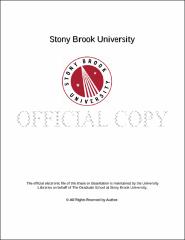| dc.identifier.uri | http://hdl.handle.net/1951/60221 | |
| dc.identifier.uri | http://hdl.handle.net/11401/71489 | |
| dc.description.sponsorship | This work is sponsored by the Stony Brook University Graduate School in compliance with the requirements for completion of degree. | en_US |
| dc.format | Monograph | |
| dc.format.medium | Electronic Resource | en_US |
| dc.language.iso | en_US | |
| dc.publisher | The Graduate School, Stony Brook University: Stony Brook, NY. | |
| dc.type | Dissertation | |
| dcterms.abstract | The IPCC-AR4 simulations project a robust poleward shift and slight strengthening of the mid-latitude jet and storm track in the Southern Hemisphere under global warming. In order to find out why the jet and storm track respond in this way, three important studies have been performed, as follows: 1) The quality of IPCC-AR4 climate simulations has been investigated by comparing model simulations with atmospheric reanalyses in terms of not only the mean flow but also storm track variations. Reanalyses data are separated into two time periods: before and after satellite, with the after-satellite NCEP reanalysis used as the reference. The primary patterns of mean flow and storm track variations and co-variability have been compared and model simulations are found to be consistent with before-satellite reanalyses, suggesting a reliable quality of IPCC AR4 climate simulations. 2) The jet north-south shift (or zonal index) mode, the leading mode of internal variability of the mid-latitude jets, has been found to exhibit a much longer auto-correlation timescale in idealized dry models compared to those in GCMs or in observations. One major difference between dry models and GCMs is lack of moist processes in dry models. Experiments are conducted by mimicking the missing diabatic heating due to moist processes in a dry model in two simple ways. Results suggest that moist heating provides a negative feedback to jet shift variations, reducing the timescale substantially, making it more comparable to that observed. 3) Different diabatic forcings representing the impact of global warming that are derived from projected temperature change between the end of 20th and 21st centuries found in IPCC-AR4 simulations, including the static stability forcing, temperature gradient only forcing, and tropopause height rise forcing, are imposed in our idealized model to test which mechanism may be responsible for causing the projected poleward shift of the jet and storm track. Experiments have been conducted using both a dry model and models with simple representation of moist processes. Results suggest that change in temperature gradient near the tropopause is most important, followed by tropopause height rise, whereas static stability change is not important. | |
| dcterms.available | 2013-05-24T16:38:15Z | |
| dcterms.available | 2015-04-24T14:47:44Z | |
| dcterms.contributor | Hameed, Sultan | en_US |
| dcterms.contributor | Chang, Edmund K. M. | en_US |
| dcterms.contributor | Swanson, Kyle | en_US |
| dcterms.contributor | Wang, Dong-Ping | en_US |
| dcterms.contributor | Zhang, Minghua | en_US |
| dcterms.creator | Xia, Xiaoming | |
| dcterms.dateAccepted | 2013-05-24T16:38:15Z | |
| dcterms.dateAccepted | 2015-04-24T14:47:44Z | |
| dcterms.dateSubmitted | 2013-05-24T16:38:15Z | |
| dcterms.dateSubmitted | 2015-04-24T14:47:44Z | |
| dcterms.description | Department of Marine and Atmospheric Science | en_US |
| dcterms.extent | 191 pg. | en_US |
| dcterms.format | Application/PDF | en_US |
| dcterms.format | Monograph | |
| dcterms.identifier | http://hdl.handle.net/1951/60221 | |
| dcterms.identifier | http://hdl.handle.net/11401/71489 | |
| dcterms.issued | 2012-12-01 | |
| dcterms.language | en_US | |
| dcterms.provenance | Made available in DSpace on 2013-05-24T16:38:15Z (GMT). No. of bitstreams: 1
StonyBrookUniversityETDPageEmbargo_20130517082608_116839.pdf: 41286 bytes, checksum: 425a156df10bbe213bfdf4d175026e82 (MD5)
Previous issue date: 1 | en |
| dcterms.provenance | Made available in DSpace on 2015-04-24T14:47:44Z (GMT). No. of bitstreams: 3
StonyBrookUniversityETDPageEmbargo_20130517082608_116839.pdf.jpg: 1934 bytes, checksum: c116f0e1e7be19420106a88253e31f2e (MD5)
StonyBrookUniversityETDPageEmbargo_20130517082608_116839.pdf.txt: 336 bytes, checksum: 84c0f8f99f2b4ae66b3cc3ade09ad2e9 (MD5)
StonyBrookUniversityETDPageEmbargo_20130517082608_116839.pdf: 41286 bytes, checksum: 425a156df10bbe213bfdf4d175026e82 (MD5)
Previous issue date: 1 | en |
| dcterms.publisher | The Graduate School, Stony Brook University: Stony Brook, NY. | |
| dcterms.subject | Atmospheric sciences | |
| dcterms.subject | diabatic heating, global warming, jet shift, jet variability, timescale | |
| dcterms.title | The impact of diabatic heating on jet variability and shift | |
| dcterms.type | Dissertation | |

